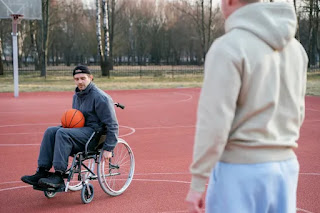What kind of wheelchairs do Para-Olympic athletes use in their day-to-day life
Some persons with impairments need equipment like mobility scooters,
wheelchairs, or prosthetic limbs to do daily duties. However, athletes
with disabilities have discovered that this commonplace equipment might
hinder their athletic performance in their quest to go higher, faster,
and longer.
Determining whether the employment of a certain technology represents "performance improvement" or, rather, is "necessary for performance" is a constant dilemma for international sports organizations as technological advancements continue to provide chances for greater athletic performance.
The typical wheelchair (or day-chair) has two bigger wheels at the back that may propel the user forward using push-rims, and two smaller wheels up front that serve as stability wheels.
The day chair's steering is accomplished by adjusting the rear wheels, which can be done by braking or propelling more forcefully on one side to make a turn.
But the specific demands of athletic use have significantly altered this traditional design. Many chairs now have a fifth wheel at the rear to prevent the chair from flipping backward during play. This is because wheelchair basketball and wheelchair tennis need quick changes in direction and high acceleration. So, mobility scooters are one of the best choices for athletes to use for their daily duties.
Also, many para-athletes use ewheels ew 36, ewheels ew 18, etc. wheelchairs for their day-to-day life needs.
History of Wheelchair sports
The Stoke-Mandeville Games, the predecessor to the current Paralympics movement, were staged in England in 1948 and included the first organized sporting event for competitors using wheelchairs. The wheelchair technology that the participating athletes had access to at the time was primitive; the wheelchairs were used for the same basic hospital transportation of patients without leg motor function that they were designed for.
A symbiotic link exists between contemporary wheelchair design and the broadening array of sports that are accessible to people with disabilities. Technology and design have kept up with the interests of athletes as new sports that can be performed in a wheelchair have been proposed and developed.
With the help of more than 150 national Paralympic organizations, the current worldwide Paralympic movement has established an organized wheelchair sports environment that develops with each Paralympic Games. The Summer Paralympic Games provide wheelchair sports in a variety of categories, with track and field sports being the most well-known. The 100-meter track event and the marathon are just a few of the competitions that wheelchair athletes compete in (26.2 mi, or 42.2 km).
Types of wheelchair athletes can use for day-to-day works
There are many various varieties of power scooters, and each one has a special set of features and advantages.
3-Wheel Scooters
Three-wheel scooters are more maneuverable in confined locations because they have a lower turning radius than conventional four-wheel ones. They are therefore the best choice for consumers who want to often use the scooter indoors. Mobility scooters with three wheels generally accommodate weight capabilities of 300 to 400 lbs and are available in a variety of designs.
4-Wheel Scooters
Scooters with four wheels are more stable than those with three wheels and frequently have larger weight capabilities. Four-wheel scooters perform well in big interior environments like malls and grocery shops, but they are better suited for outdoor use because of their broader turning radius.
Mobility scooters
Portable mobility scooters may be conveniently transported in a car trunk by folding up or disassembling. These scooters are ideal for people who often travel or have active lifestyles. They are the type of scooter that is lightest, but they also have the lowest maximum weight capacity.
Regular Scooters
Portable scooters are smaller than standard scooters. They have bigger batteries, which let the rider travel further on a single charge, and more roomy seating and storage than their lightweight competitors. Due to their added size and weight, standard mobility scooters are a little more challenging to move.
Conclusion
Outside of the Paralympics, wheelchair racing has remained popular. For many years, wheelchair divisions have been offered at several international marathons. These specialised vehicles have smaller lead wheels constructed on an extended structure from the wheelchair, as well as bigger than usual wheels for propulsion. Additionally, Scootaround has numerous possibilities to offer, particularly for athletes. Get in contact with Scootaround right away to learn more!


.jpg)

Comments
Post a Comment